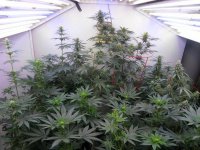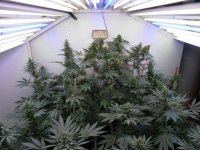Riddleme
Member
Just wondering how you're quantifying any change and why you think your plants experience midday depression of photosynthesis?
To be honest, I'm not sure if they do or not, they grow great, lots of vigor but by midday there are a few fluctuations in temp and humidity. I grow in an open (not sealed in anyway) room in my basement lights off temp currently 72 goes up to 78 with lights on canopy temp reaches 90 by noon (ambient stays at 78) I do my best to mimic outdoors this way RH changes a couple of points up by midday, so it is something I want to see? I have a microscope camera so I guess I could look at the stomata to record changes?
I have grown for over 40 years so to quantify I would normally go by simple observation as to whether anything in terms of plant response changes I have run some strains for years so I know what to expect from em I very rarely have any problems
Since it is a seed run it won't hurt anything to find out?
my garden ,,,,,,






